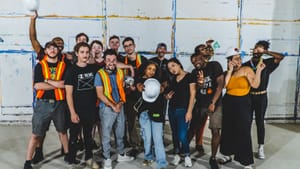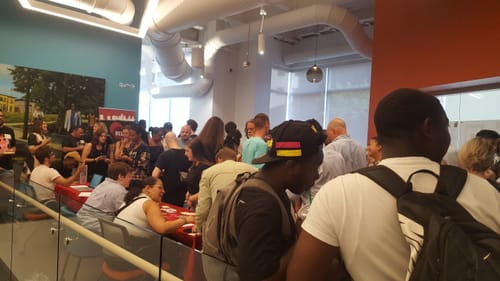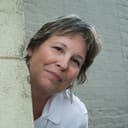Stay in the Loop
BSR publishes on a weekly schedule, with an email newsletter every Wednesday and Thursday morning. There’s no paywall, and subscribing is always free.
A new creators’ space by the old Market East
REC Philly announces a major footprint in the new Fashion District

Among the excited young guests at a July 30 town hall where REC Philly announced the opening of a new 10,000-square-foot creative facility in the freshly branded Fashion District this fall, a diverse group of artists and adjunct professionals were anxious to hear what co-founders David Silver and Will Toms would say.
The new REC (Resources for Every Creator) Philly space, at 9th and Market Streets, will serve more than 3,000 creators with recording studios, visual labs, a podcast studio, rehearsal space, production rooms, meditation rooms, private conference rooms, coworking office space, and a 200-seat event venue. There will also be a public café and retail store to sell merchandise and artwork. Silver and Toms (friends as well as cofounders) plan to continue REC’s educational programming and related events to provide the community infrastructure for independent creators of wide-ranging disciplines to build, sustain, and scale their businesses.
School days
The founding duo met as juniors at William Tennent High School in Bucks County. Silver laughs, remembering their school days: “We bonded creating media together, starting with Will producing afternoon school announcements and I was the weatherman.”
Their collaboration only grew from there.
“All of our friends were musicians, singers, and hip-hop artists growing up and we were always looking to help each other grow as artists, as entrepreneurs,” Silver adds. “That’s really where this comes from. It started as a passion to help our friends and wanting to create a career around the things that we loved to do.”
During college (Silver at Temple and Toms at Indiana University of Pennsylvania), they pursued their passion by “throwing shows” all around Philly, from “dive bars” to World Café Live, learning professionalism with each event.
From sweat equity to investors
Toms saysfinding quality venues was tough at first. “We felt if it was challenging for us, specifically as businessmen, I can only imagine what it must have been like for the artists themselves to find venues and opportunities.”
In the beginning, with no investors, it was “all muscle,” he continues. The pair used their sweat equity to negotiate with venues, booking off nights, and playing for the door. Between 2013 and 2015, they produced 300 shows. In 2015, their energy paid off with the launch of REC, whose mission included experimenting with unique programming, like combining musical genres for shows (think “a hip-hop artist with a classical cellist”) along with constructing a web of alliances to move the project forward.
“We helped the artists find professionals like entertainment lawyers or videographers through the network we developed. We were all helping each other, building a network, building community,” Toms explains.

They found sponsors and investors for their dream, too.
They proved themselves in their first place, a 600-square-foot venue in North Philly. “We asked people, ‘Do you want to be a part of this creative story?’” Toms says. It turned out they did. “Our vision and business model made sense to them.”
Capitalizing on Philly
REC leaders note they have sourced $3.2 million in capital to date, with $1.1 million raised by private investors and community leaders such as Steven Finn of LocalStove catering company; entrepreneur and philanthropist Chase Lenfest; local real-estate titan and Philadelphia council member-at-large Allan Domb; Jon Gosier, founder and CEO of Southbox Entertainment; Mia Tinari, global head of marketing and communications at TAIT; and Natalie Nixon, president of Figure 8 Thinking.
“REC’s techniques for building entrepreneurial muscle and community for practitioners in the creative economy is an innovative model to scale around the world,” Nixon says.
Why Philly?
“We’re from the area and when we started throwing events, we wanted to start right in our home town,” Toms says. He calls Philly “the very best place in the world to do what we wanted to do,” because of its musical history, the creatives who live here, and folks looking for entertainment and a great night life. “We learned how lucky we were being from Philadelphia.”
A worthwhile investment?
Membership may be a problem, though. The monthly fee (currently $40 to $80) will be raised by $9 once the move is made, and that’s an investment many artists cannot afford. Poet Lindo Jones (a REC member for 18 months) told the Inquirer that these opportunities were more suited to musicians and audio engineers, and it wasn’t worth it to him.
But Toms insists there will be sponsored memberships for some people who cannot afford the monthly fees, and that membership is important, so artists learn entrepreneurship and business practices to help them succeed. (REC representatives also note a 10 percent membership discount for Temple students.)
Their corporate slogan is “Independent doesn’t mean alone,” and with the larger space, both Toms and Silver feel the cultural climate and resources they’ve built will draw artists from New York and other cities to work here.
Here’s hoping many Philadelphia creators find the REC enterprise worthwhile.
Sign up for our newsletter
All of the week's new articles, all in one place. Sign up for the free weekly BSR newsletters, and don't miss a conversation.
 Suzanne Cloud
Suzanne Cloud